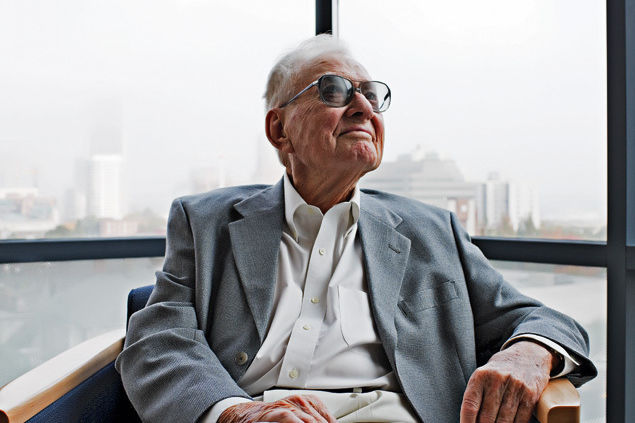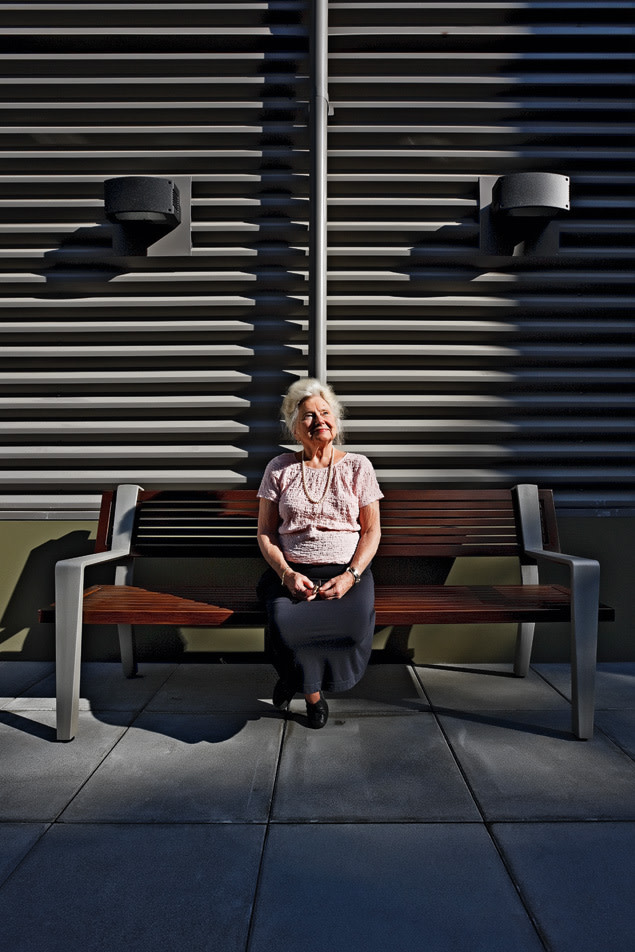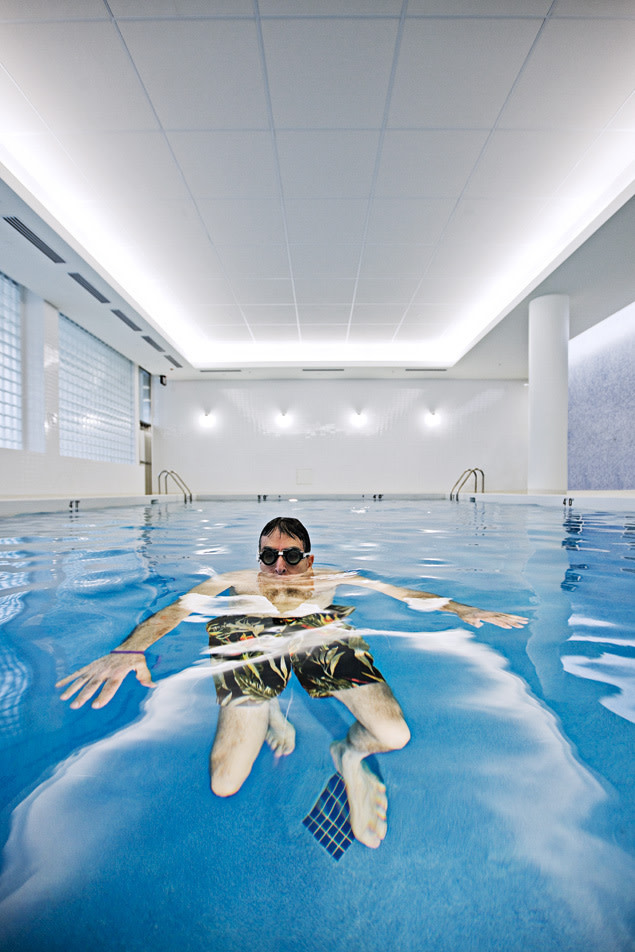
Golden Age
“This,” Bob McDowell begins, hunkering his shoulders slightly, like a magician about to spring a trick, “is a very strange story ….”
Most of McDowell’s stories could be sold with such a flirtatious prologue, but frankly, the hard sell is unnecessary. Regardless of whether they’re strange or odd or merely downright unbelievable, his stories are always good. They’re also usually epic, delivered in a wide-eyed, excitable barrage of run-on sentences. When he gets going on one of his intricate yarns, it’s best to get out of the way.
“I’m in the Oakland airport,” he says, hands folded neatly at the bald eagle crest on the chest of his navy blue polo, “and I’m sitting next to a gentleman who was probably in his 90s. Very dignified. And we started talking and suddenly I realized I had been with this fellow in Anawetok for the atomic hydrogen [test] series in 1955. He was in the Naval security there. He said he was living in a retirement facility north of Oakland: a Quaker facility. So we started talking about it because I was at the point of retirement, too. He said, ‘Come down and take a look at it … but are you a political activist? Because they only take political activists.’ I told him I was, but when I visited the place—a really incredible place—they told me that because so many people wanted in, there was a 10-year waiting list. They said to me, ‘But you’re from Portland. You have a really great facility already. We recommend it to people who don’t want to wait 10 years.’”
In essence, Terwilliger Plaza—a high-end retirement complex on the fir-lined lower porch of the West Hills—was McDowell’s Plan B. And although volunteering for peace movements and conscientious objecting are both worthy pursuits, it’s hard to imagine, as the second of four courses lands on our table in this private dining room, that the 73-year-old might be skipping town anytime soon for a simple life with the Quakers. Seared scallops the size of tea saucers float on lobster bouillon; leaflets of chanterelle-mushroom toast bookend the plate. Before either of us can even lift a fork, waiters in crisp white shirts appear over our shoulders, deft with pours from a 2006 Sancerre for us and the 15 other guests at this monthly limited-seating meal. Our chef, Klaus Monberg, a jovial bearded fellow with a Scandinavian accent who’s run restaurants in San Francisco and Manzanita, explains that “because of the chalky soil in the [Sancerre] region, you might get tastes of citrus and apple. You also might taste grass.” It’s a charming sentiment, but considering that this is our third flight of wine so far this evening, most of the assembled grandmothers and great-grandfathers have long passed the point of swishing for flourishes of tobacco and leather. We’re not sipping anymore.
And because of the chugging, things are getting a little boisterous. I met the three people sitting next to me only 45 minutes ago, but with unapologetically flushed faces we’re already bonding. Across the table, 93-year-old Art Balinger is three-piece-suit dapper, his white hair still full and slicked back, pretty much what you’d expect from a pre-TV radio announcer who worked on classics like The Roy Rogers Show. “Lots of Philip Morris commercials,” he says, his golden throat dulled but still commanding. Sitting next to him, Anne Kronenberg, who looks at least 15 years younger than the 85 she claims, speaks in birdlike tones about her time spent visiting the cavernous sawmills of Weyerhaeuser, where her husband worked. Leaning in from my right, McDowell continues in conspiratorial near-whispers with his dishy gossip about one of the residents, said to be the grandson of Frederick Law Olmsted, the famed designer of New York’s Central Park. McDowell once managed the Kaiser Permanente art collection, the largest corporate stockpile in the Pacific Northwest; a piece from his personal collection—a mixed-media abstract painting—looms over tonight’s meal.
Both in mood and, in tonight’s case, sheer alcohol content, Terwilliger feels nothing like a retirement home. Before dessert even arrives, plans are being hatched to slip back up to Balinger’s place for some wine from his personal stash, which he keeps replenished with monthly shipments from a small vineyard in California. Tucked away as we are in a private, wood-paneled dining room, it’s easy to forget that beyond these soundproofed walls, in any one of the 248 rooms that make up Terwilliger, someone might be taking his last breath or struggling to remember her child’s name.
A reminder jerks his walker through the door midway through the cheese plate. His eyes are wide with what can only be dementia. The seat of his pants bulges from the adult diaper he wears out of necessity. “Where can I sit?” he asks in a hollow, childlike voice. The mood of the room is eclipsed by an awkward pall, a kind of ignore-it-and-it’s-not-happening uneasiness usually reserved for panhandlers. A waitress steps in and politely steers the gentleman toward the general dining area. “But I want to sit here,” the man pleads, continuing to protest as he’s led away.
The rest of us just keep chewing. And drinking. The next flight of wine arrives, a salve with a delicate bouquet of peach and honeysuckle. It’s a lovely Moscato d’Asti from Italy, and it tastes like distraction.

Terwilliger resident Betty Perkins on a common patio, one of the Plaza’s many shared spaces for entertainment and relaxation.
Image: Daniel Root
Someday, maybe 40 years from now, I might pick up a stone and with a feeble right arm throw a rock in the general direction of Terwilliger Plaza. Not just because I’ll never be able to afford to live there—a basic membership is currently pegged anywhere between $30,000 and more than $600,000, and monthly fees average $1,700—but also because I’ll know what goes on inside Terwilliger, surely the most regal, forward-thinking retirement facility in Portland.
In fact, to call Terwilliger something as vanilla as an old folks’ home seems insulting. In brochure-speak it’s an internationally accredited continuing care retirement community, a 12-story monolith with a variety of retirement residences, from independent living to assisted living and residential care, but that’s kind of like referring to the Taj Mahal as just some grave in India. Anne Kronenberg, my pal from the private dinner, says with a girlish giggle, “It’s more like a sorority house here.”
Slap that on your advertising propaganda: Terwilliger Plaza, the great big Greek keg party in the woods. Once you get past the building’s drab concrete exterior—it opened in 1962 and looks like a stand-in for General Hospital—the description certainly holds up. From the moment you walk in, the place sizzles with geriatric energy. An abundance of sunlight pours through the large, glassed-in foyer, a see-through effect that extends along the eastern face of the building, covering the entryway, the library, and the common dining room. On a typical afternoon the lobby is all white noise. A visiting family logs in at the reception desk; four residents sun themselves in lounge chairs; a group of six ladies back from a matinee of Guys & Dolls at the Gerding Theater waits for the elevator; and a woman in her 80s motors past them all in a black scooter with silver metallic flames. Everybody—everybody—is firing off conversation with all the subtlety of an Uzi.
“Usually you get into an elevator and everybody looks down,” McDowell says. “Our elevator? You want to shake people sometimes, there’s so much talking.”
Maybe it’s overstimulation. Besides necessities like the on-premises bank, grocery store, thrift market, deli, salon, and private rooms for massage therapy, Terwilliger hosts guest speakers and free performances from chamber musicians and opera understudies who drop by on an almost-weekly basis. Or residents can just stay in and watch the in-house theatrics of the Plaza Players in the auditorium. “I live on the floor with those people,” Kronenberg says. “When I first moved in they were like, ‘Good, you’ll be in the plays.’ I told them, ‘Nope. I go to plays, I’m not in plays.’”
There’s also a massive gym the size of two basketball courts with elliptical machines, Keiser equipment, personal trainers, and classes in everything from ab-blasting core training to yoga, pilates, and tai chi. Even the oldest residents, whose joints may be too battered for intense exercise, can play virtual tennis or bowling on a new Nintendo Wii set up in one corner.
On the roof, an ivy-trimmed gazebo deck gives a commanding 360-degree view of Portland; bronze markers point out the mountainous vistas in the distance. Off to the right is a narrow, 50-foot pathway lined on each side by tomatoes. It’s called “tomato alley,” and during the summer, competition for a healthy vine can get heated. “If somebody finds out someone else is picking their tomatoes,” says Terwilliger’s president and CEO, Dee Sellner, “there’s usually trouble.”
The Tower’s 200 rooms house the majority of the Terwilliger population. The apartments range from a 378-square-foot studio to a 1,160-square-foot two-bedroom. All include full kitchens and have flooring and countertops customized to individual taste. Touring the rooms is about the time when prospective residents at a typical open house start crunching numbers in their head. Prices vary according to size and view, but even the smallest residence requires a one-time $30,000 membership fee (which gives residents access to all Plaza services, facilities, and on-site health care) as well as $731 in monthly maintenance. The largest Tower apartment peaks at a $366,000 membership fee and $2,191 in monthly maintenance. “We try to stress the fact that we’re affordable,” says Sellner, “but word gets out. Not everybody can be a multimillionaire.”

At the Heights, residents have access to a heated pool and sauna, as well as a Zen garden, a bistro, and views of Mount Hood.
Image: Daniel Root
Although it might help. Especially if you’re eyeing a spot in Terwilliger’s recently completed new wing, appropriately named the Heights. Connected to the rest of the building by a sky bridge, its 10 stories and 48 units push past mere luxury and into the realm of indulgence. Housed in the modern concrete-and-steel exterior are a heated pool and sauna, a Zen garden, and a bistro bar where residents can enjoy wine and a rotating array of tapas next to a well-stoked fireplace. Residents enjoy all the amenities of Terwilliger, but the apartments—both in design and price—suggest something more along the lines of New York’s Upper West Side. All have two bedrooms and range between 1,300 and 1,900 square feet; all have a deck with knee-buckling views of Mount Hood, as well as an in-room washer and dryer, the lack of which is a fairly common complaint among other Plaza dwellers. It can all be yours for an average membership fee somewhere in the neighborhood of half a million dollars and monthly “rent” of $2,450 to $2,995.
Betty Perkins’s pad is typical of the Heights: glistening handpicked hardwood floors, kitchen countertops of fanciful yellow tile, walls lined with art, Pavarotti on the stereo. She removed one interior wall to make room for her grand piano and handmade harpsichord; every inch of shelf space is gobbled up by books. At the base of her large living room window are dozens of photos—most are shots of her daughter (who worked on the Obama campaign) posing with Barack and Michelle Obama. “She’s in Ohio right now, going door-to-door in the ghetto,” Perkins says excitedly. “They told her she shouldn’t wear any jewelry.” Beyond the window, the Willamette River shimmers like an oil painting.
“This is what this generation of retirees wants,” says Sellner. “They want to live their life, they want nice things, and they don’t want to feel like they’re compromising. Most important, they want to be in control.”
That last bit, especially, is taken literally. These sorts of elderly ivory towers are nothing new, after all. Even locally, papaw palaces like Willamette View, in Milwaukie, and Mirabella, a tower currently under construction on the South Waterfront, are drawing the more affluent members of the 60-plus crowd. And the Springs at Tanasbourne will bring upscale retirement living to the doorstep of the shopping malls in March 2009.
Still, Terwilliger singles itself out. Its residents’ average tax bracket may have shifted since the Plaza was founded by a group of retired teachers, but its method of operation hasn’t: Now as then, Terwilliger is a self-governed facility, a unique trait not just locally but nationally. Resident representatives on each floor report to a 10-member board of directors made up of residents and a few outside professionals. Everything—from the choice of meals, the lobby’s air temperature, and the art on the walls—is subject to a vote. Majority rules. “It’s not lip service, either,” says McDowell. “We play a major role in the decision-making. For instance, we just finished a project to remodel the main lobby. That was a project that we voted to do, and we got it done.”
No other accredited Oregon retirement community is thought to have this type of structure, and, according to the Commission on Accreditation of Rehabilitation Facilities, which accredits 5,200 service providers in the United States and Canada, only two others in the country have anything similar. “I believe it’s indicative that we call the people that reside here ‘members,’” Sellner says. “Because they truly are, and they have a say in the voting process.”

Resident Mary Ellen Higgins at the Heights. Terwilliger’s new 48-unit luxury wing.
Image: Daniel Root
Bob McFarlane chairs the board. With his cherubic mug, he’s the star of Terwilliger’s commercial literature and the facility’s de facto poster boy. The first time I meet him he’s drinking wine, eating a fig-and-goat-cheese tart, and smoothly schmoozing at an open-house luncheon in the tapas bar. He used to be a thoracic surgeon and for a time was chief of surgery at Kaiser Permanente. This afternoon, his sunburned cheeks glow above his white beard, the sign of a long weekend spent sailing on Puget Sound.
He can’t talk for long, though. Just a brief hover and a handshake and it’s back to recruiting. After all, at these prices, the units in the Heights aren’t going to fill themselves. With a wink he says, “Maybe we’ll see you around someday.”
Yeah. And maybe I should start saving. Right now.
The population of Multnomah County residents age 60 and older was just under 95,000 in 2000, according to US Census figures. By 2010, that number is expected to swell to about 104,000, according to projections by the Population Research Center at Portland State University. The vast majority will not likely be able to afford to live in a place like Terwilliger Plaza.
The most fortunate will have enough money left to remain independent. If they’re really lucky, they’ll stay healthy enough to keep living in their own homes. Still, most of those who move to Oregon care facilities will end up in corporate-run, for-profit systems like those of Sunwest Management, a Salem-based retirement home operator with properties nationwide. So while a recent lead news story on Sunwest’s website was honest, it was also a little unsettling: “California Department of Justice Closes Investigation Concerning Sunwest.” The two-year inquiry centered on reports of patient neglect at two California properties.
While those claims were ultimately disproved, they’re worth mentioning, if only because Sunwest is the nation’s fourth-largest assisted-living provider—or was until it was forced to shed 132 properties totaling $1 billion in the face of financial, regulatory, and legal problems. While the 2005 claims didn’t stick, this year Sunwest suffered a $5.5 million judgment in a pair of class-action suits alleging unlawful business practices, false advertising, and consumer act violations at various properties in California and Oregon.
That might explain why receptionists at three local Sunwest properties were skittish when I called to ask about setting up a tour. Calls to Hawthorne Gardens Senior Living Community and Oswego Springs Assisted Living Community went unreturned. Ditto a message left with the receptionist at Park Place Assisted Living Community. Only Sellwood Landing was more than happy to show me around. And what they had to offer was nice. If Terwilliger is a Marshall amp revved up to 11, Sellwood is a solid 6. Located just across the Sellwood Bridge in a neighborhood loaded with Victorian homes, it sits on the block as a giant rectangle of robin’s egg blue. Inside, a ’50s-themed cafe (the Coca-Cola Room) is decked out in retro sock-hop style and cardboard cutouts of Laurel and Hardy; it’s the perfect spot for nickel bingo. The main dining room (where most meals are eaten, since most of the apartments don’t have full kitchens) is expansive, though drab furnishings give it the feel of an extended-stay hotel. Rent at Sellwood is month to month and runs from $2,795 for a studio to $6,045 for a two-bedroom apartment. Views range from the suburban charm of the local neighborhood to the parking lot of Foster’s convenience store.
Upstairs, the activities room consists of a couple of old-school stationary bikes, a few five-pound dumbbells, and some board games. In the billiards room: a pool table. A common-use oven, on the fourth floor, allows for occasional baking. Today, though, the halls are empty. Granted, there was a field trip to Trader Joe’s on the schedule, but the building has 85 apartments, and the only residents I see are a couple napping in lounge chairs in the lobby.
“I did [home] alarm sales before I came here,” says Chris McKee, a Sellwood sales manager. “It’s kind of the same thing here. You sell yourself to a certain degree. Is somebody willing to trust you with the care of their parent? Are they comfortable with you? I think about those things when somebody comes in the door, but no more so than if you’re selling a car.”
What he’s saying is, you buy things from people you trust.
Elder care is a business. And that’s OK. But if the past few months have taught us anything, it’s that any publicly held company is fair game in a recession.
A 2001 report from the National Health Policy Forum hailed Oregon as a national model for its long-term-care system, which emphasizes home- and community-based care. But recent history—at least the history played out in the court of public opinion—has not been kind. And not just in high-profile cases like that of the Pearl at Kruse Way, in Lake Oswego, which was sued by the family of 86-year-old Elvera Stephan. In May, Stephan, who suffered from dementia, was handcuffed and restrained by police who were called to the scene, while nurses and attendants did nothing. The family won a $904,200 judgment.
A recent analysis by the New York Times showed that nursing homes delivered substantially worse care to residents after being bought by a corporation, findings two Harvard Medical School professors refuted last year in Health Affairs, a peer-reviewed national medical journal.
Locally, a recent analysis of Oregon senior-care organizations by the Pamplin Media Group showed that for-profit care ventures in Oregon are cited for injuries and violations more frequently than are their nonprofit counterparts. Earlier this year, the Oregon Department of Human Services even tried and failed to get the Legislature to raise penalties and licensing fees—which would have funded training for caregivers—with the hope that the number of violations could be curbed. Both measures may appear on the legislative calendar in 2009.
The decision between breaking the bank on a high-rise retirement facility or taking chances on a for-profit home has helped create what Mary Shortall, who heads the Multnomah County Aging and Disability Services division, calls the “sandwich generation”—people who suddenly find themselves in the challenging position of caring for their aging parents as well as their growing children.
“It’s forcing us to start thinking about long-term insurance at a younger age,” Shortall says. “People need to plan for aging now: what your life might look like, your housing, your transportation, your finances. And not just your own, but how you might handle having to take care of your parents.”
The lack of a plan is why some people end up in Rebecca Childs’s office. As housing program manager for the Northwest Pilot Project, an agency that helps low-income seniors find a place to live, she’s often the last hope for those who are struggling just to get by.
“Some have been stable for a long time, but then they have a health crisis that creates the loss of their longtime home and all their stuff,” Childs says. “And suddenly they’re looking for a place to live. It’s an emotional process, and we have to work on readjusting their expectations.”
Childs says she sees nearly 1,700 low-income elderly people a year. Because of waiting lists for public and other subsidized housing—some senior citizens wait as long as two years—she’s able to place fewer than 500 people each year.
She insists she’s glad a place like Terwilliger exists, yet she can’t help offering up a sigh at the thought of four-course meals and massages.
“It’s great to have a range of options if you can afford it,” she says, “but I really want to see us as a city take care of the people who don’t have those types of resources.”
Dee Sellner will go to great lengths to keep her Plaza population happy. But she’s a professional. So no matter how much Bob McDowell keeps pestering her for a gin and tonic, and no matter how nicely Art Balinger pleads for a vodka rocks with a lemon twist, Sellner refuses. She is a CEO, not a cocktail waitress.
“Serve yourselves, boys,” she says, excusing herself from the room and leaving cackles in her wake. McDowell, Balinger, Kronenberg, and I are sitting in a small office at the Plaza, rehashing our private dinner from a few weeks ago, particularly the part about the gentleman who, perhaps unbeknownst even to himself, crashed the party. Mortality is an uncomfortable topic for anyone, but when broaching the subject with those who, given their age, might already see it in their periphery, it’s even more so. Still, I have to ask: What happened to him?
“Some people wander when they don’t mean to,” Kronenberg says. “They don’t have a lockdown here, so if you’re a wanderer, you can’t stay.” There’s a beat of silence, but instead of the morose reaction I feared, they steer the conversation toward the man’s life before his condition forced him to leave Terwilliger for the nursing unit. His family. His friends here. His life in medicine. It’s a nice circling-the-wagons moment. “There are men and women here who have done some wonderful things,” Balinger says. “There was a time when I’d see all these people in wheelchairs … Now I’ve got a walker of my own. I can relate. I’m with old people who are just as old as ‘Old Art.’ It’s comforting.”
Another comfort is that, for the third time in as many visits, some attractive elderly woman (it’s never the same one) has just popped her head in to offer to bring Balinger dinner in his apartment. He accepts coolly, but like Bogart in his prime, he does so with an ultimatum: “Just make sure it’s there by 5:30. The debate’s on at 6.”
As for McDowell’s evening, it sounds like it has as many possibilities as that of a teenager who just got his driver’s license. “Let’s see,” he says, running through a mental checklist. “There’s a chamber music performance this evening. I could go to the gym and work out, I suppose. Or maybe I’ll just head down to the track.”
Balinger rolls his eyes and lets out a withering mock sigh. He takes the handles of his walker and gives them a light shake. “That’s what’s so beautiful about being 73,” he laughs. “You feel like you’re indestructible.”




